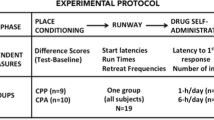Abstract
Amphetamine-induced circling behavior increases over the course of repeated administration of the drug; likewise, after repeated administration of amphetamine, an injection of saline prior to placement of the rat in the test apparatus previously associated with the pharmacologic effects of amphetamine will increase circling behavior. Experiments were designed to determine if either of these effects would respond to manipulation of the temporal contiguity between the test environment and the peak effects of amphetamine. The placebo-like response, in accordance with a Pavlovian conditioned response, was reduced by prior non-reinforced exposure to the test environment and subject to extinction. In contrast, the increase in the amphetamine-induced response was entirely dependent on the test environment but not affected by latent inhibition or extinction. These and previous findings indicate that the development and expression of the placebo-like response is the result of a Pavlovian associative process. Although amphetamine sensitization is environment dependent, it does not resemble a conditioned response in other respects.
Similar content being viewed by others
References
Barr GA, Sharpless NA, Cooper S, Schiff SR, Peredes W, Bridger WH (1983) Classical conditioning, decay and extinction of cocaine-induced hyperactivity and stereotypy. Life Sci 3:1341–1351
Becker JB, Robinson TE, Lorenz KA (1982) Sex differences and estrous cycle variations in amphetamine-elicited rotational behavior. Eur J Pharmacol 80:65–72
Bracha HS, Seitz DJ, Otemaa J, Glick SD (1987) Rotational movement (circling) in normal humans: sex differences and relationship to hand, food and eye preference. Brain Res 411:231–235
Brass CA, Glick SD (1981) Sex differences in drug-induced rotation in two strains of rats. Brain Res 223:229–234
Browne RG, Segal DS (1977) Metabolic and experiential factors in the behavioral response to repeated amphetamine. Pharmacol Biochem Behav 6:545–552
Carey RJ (1986) Conditioned rotational behavior in rats with unilateral 6-hydroxydopamine lesions of the substantia nigra. Brain Res 365:379–382
Drew KL, Glick SD (1987) Classical conditioning of amphetamine-induced lateralized and nonlateralized activity in rats. Psychopharmacology 92:52–57
Eikelboom R, Stewart J (1981) Conditioned temperature effects using amphetamine as the unconditioned stimulus. Psychopharmacology 75:96–97
Glennon RA, Young R (1984) Further investigation of the discriminative stimulus properties of MDA. Pharmacol Biochem Behav 20:501–505
Glick SD, Cox RD (1978) Nocturnal rotation in normal rats: correlation with amphetamine-induced rotation and effects of nigrostriatal lesions. Brain Res 150:149–161
Glick SD, Shapiro RM (1985) Functional and neurochemical mechanisms of cerebral lateralization in rats. In: Glick SD (ed) Cerebral lateralization in nonhuman species. Academic Press, New York, pp 157–183
Glick SD, Hinds PA, Shapiro RM (1983) Cocaine-induced rotation: sex-dependent differences between left- and right-sided rats. Science 221:775–777
Glick SD, Shapiro RM, Drew KD, Hinds PA, Carlson JN (1986) Differences in spontaneous and amphetamine-induced rotational behavior, and in sensitization to amphetamine, among Sprague-Dawley derived rats from different sources. Physiol Behav 38:67–70
Greenstein S, Glick SD (1975) Improved automated apparatus for recording rotation (circling behavior) in rats or mice. Pharmacol Biochem Behav 3:507–510
Hinson RE, Poulos CX (1981) Sensitization to the behavioral effects of cocaine: modification by pavlovian conditioning. Pharmacol Biochem Behav 15:559–562
Jerussi TP, Glick SD (1976) Drug-induced rotation in rats without lesions: behavioral and neurochemical indices of a normal asymmetry in nigro-striatal function. Psychopharmacology 47:249–260
Johanson CE (1984) Assessment of the dependence potential of cocaine in animals. In: Grabowski J (ed) Cocaine: pharmacology, effects and treatment of abuse. NIDA Research Monograph 50, Washington DC
Leith NJ, Kuczenski R (1982) Two dissociable components of behavioral sensitization following repeated amphetamine administration. Psychopharmacology 76:310–315
Mackintosh NJ (1974) The psychology of animal learning. Academic Press, New York
Mazurski EJ, Benninger RJ (1987) Environment-specific conditioning and sensitization with (+)-amphetamine. Pharmacol Biochem Behav 27:61–65
Pavlov IP (1927) Conditioned reflexes. In: Anrep GV (ed) Conditioned reflexes. Dover Publications, New York, 1960
Post RM, Lockfeld A, Squillace KM, Contel NR (1981) Drugenvironment interaction: context dependency of cocaine-induced behavioral sensitization. Life Sci 28:755–760
Robinson TE (1984) Behavioral sensitization: characterization of enduring changes in rotational behavior produced by intermittent injections of amphetamine in male and female rats. Psychopharmacology 84:466–475
Robinson TE, Becker JB, Ramirez VD (1980) Sex differences in amphetamine-elicited rotational behavior and the lateralization of striatal dopamine in rats. Brain Res Bull 5:539–545
Robinson TE, Becker JB, Presty SK (1982) Long-term facilitation of amphetamine-induced rotational behavior and striatal dopamine release produced by a single exposure to amphetamine: sex differences. Brain Res 253:231–241
Segal DA, Mandel AJ (1974) Long-term administration of d-amphetamine: progressive augmentation of motor activity and stereotypy. Pharmacol Biochem Behav 2:249–255
Shannon HE (1980) MDA and DOM: substituted amphetamines that do not produce amphetamine-like disriminative stimuli in the rat. Psychopharmacology 67:311–312
Tilson HA, Rech RH (1973) Conditioned drug effects and absence of tolerance to d-amphetamine induced motor activity. Pharmacol Biochem Behav 1:149–153
de Wit H, Stewart J (1981) Reinstatement of cocaine-reinforced responding in the rat. Psychopharmacology 75:134–143
Author information
Authors and Affiliations
Rights and permissions
About this article
Cite this article
Drew, K.L., Glick, S.D. Characterization of the associative nature of sensitization to amphetamine-induced circling behavior and of the environment dependent placebo-like response. Psychopharmacology 95, 482–487 (1988). https://doi.org/10.1007/BF00172959
Received:
Revised:
Issue Date:
DOI: https://doi.org/10.1007/BF00172959




